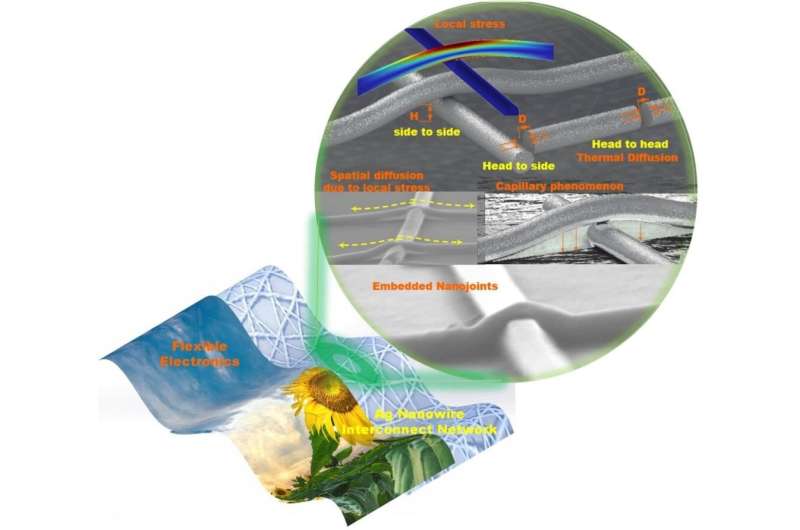The three types of joints in Ag nanowire interconnection networks have different morphological characteristics under thermal excitation, especially in the form of side-to-side joints, which will exhibit fluid-like capillarity in the nanopores under local stress and form embedded nanojoints in the resulting induced surface diffusion and infiltration. Credit: Jianlei Cui, Xiaoying Ren, Xuesong Mei, Zhengjie Fan, Chenchen Huang, Zhijun Wang, Xiaofei Sun and Wenjun Wang.
Researchers from Xi'an Jiaotong University revealed the atomic flow behavior of nano-joints in AgNWs Interconnect Network. In order to further improve the joint quality, the thermal welding process and atomic evolution behavior of Ag nanowires were studied through a combination of in situ experimental and molecular dynamics simulations.
The team systematically analyze the atomic flow behavior during the formation of different types of Ag nanowire joints. The influence of processing time, temperature, and stress distribution due to spatial arrangement on nanojoints was systematically explored. What's more, the failure mechanisms and their atomic interface behavior of the nanojoints were also investigated. These results may advance the industrial application of Ag nanowire interconnection networks in flexible electronics and transparent conductive films.
As the size of nano-joints shifts to the nanoscale, their thermal sensitivity increases significantly and the study of the temperature dependence of joints and thermal defect damage mechanisms during their welding process becomes increasingly important. For Ag nanowires, there is a more pronounced capillary phenomenon in the nano-gaps during welding and their weld morphology is subject to local stress in addition to temperature.
For thermally induced welding methods, the final quality of the joint is sensitive to the initial spacing and alignment direction between the nanowires. Three types of nano-joints can be obtained during the welding process: head-to-head, head-to-side (T-shaped) and side-to-side (X-shaped) joints. For the first two joint forms, the weld morphology is mainly influenced by the horizontal pitch in addition to temperature. For X-shaped nano-joints, in addition to temperature, the joint shape is greatly influenced by local stresses due to the spatial structure of the top and bottom.
One of the lead researchers, Professor Jianlei Cui, commented, "The characteristics of the joint in the interconnected network of AgNWs are not only influenced by the temperature, but also by the local stress and its interaction with the substrate, at the same time capillary interactions show a non-negligible influence in interfacial flow at the nanoscale. Furthermore, within the right temperature range, the atomic flow of the joint becomes more and more adequate with increasing treatment time and the quality of the joint becomes better and better."
The in-situ heating system of the electron microscope allows us to directly observe and analyze the evolution of the atomic morphological features during the welding of Ag nanowires. The author Xiaoying Ren explained, "In our work, we directly observed the excitation and resorption of a large number of Ag nanoparticles on the surface of AgNWs during thermal excitation, and the mechanism of nanoparticle formation may be due to capillary-induced surface diffusion and permeation."
The excitation and reabsorption of these nanoparticles is accompanied by a gradual filling of the nanogaps with Ag atoms, forming fully welded nano-joints with increasing time.
To further investigate the effect of local stress on X-shaped nano-junctions, the authors found that AgNWs generate certain stress concentrations in the parts with curvature, and these parts usually show local damage or fracture under thermal excitation in the following process.
During the formation of an X-joint, the upper nanowires will flow violently under the influence of local stress and temperature, and their atoms will flow along the surface of the lower nanowires, eventually forming an encapsulated nano-joint, which leads to the formation of a large number of defects on both sides of the upper nanowire joint, and these X-shaped nano-junctions are the first to fracture on both sides of the upper nanowires during the later thermal excitation process.
In order to further analyze the evolution of the atomic behavior of Ag nanowires under thermal excitation and the mechanism of thermal damage, the author Chenchen Huang said that "We have systematically analyzed the Rayleigh destabilization of Ag nanowires under thermal excitation using molecular dynamics simulations, and the results show that Ag nanowires form equally spaced nanoparticles due to Rayleigh destabilization at high temperatures."
Professor Xuesong Mei said, "How to effectively improve the welding quality of AgNWs joints and ensure the application stability of the joints has always been the focus of research. With the further integration and miniaturization of devices, the thermal sensitivity and thermal damage mechanisms of nano-joints in the application process will also attract more and more attention in the future."
The study is published in the International Journal of Extreme Manufacturing.
More information: Jianlei Cui et al, Morphological characteristics and atomic evolution behavior of nanojoints in Ag nanowire interconnect network, International Journal of Extreme Manufacturing (2023). DOI: 10.1088/2631-7990/acc434
Provided by International Journal of Extreme Manufacturing
























